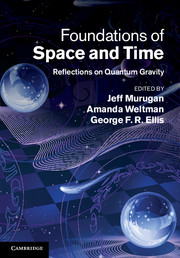Book contents
- Frontmatter
- Contents
- List of contributors
- 1 The problem with quantum gravity
- 2 A dialogue on the nature of gravity
- 3 Effective theories and modifications of gravity
- 4 The small-scale structure of spacetime
- 5 Ultraviolet divergences in supersymmetric theories
- 6 Cosmological quantum billiards
- 7 Progress in RNS string theory and pure spinors
- 8 Recent trends in superstring phenomenology
- 9 Emergent spacetime
- 10 Loop quantum gravity
- 11 Loop quantum gravity and cosmology
- 12 The microscopic dynamics of quantum space as a group field theory
- 13 Causal dynamical triangulations and the quest for quantum gravity
- 14 Proper time is stochastic time in 2D quantum gravity
- 15 Logic is to the quantum as geometry is to gravity
- 16 Causal sets: discreteness without symmetry breaking
- 17 The Big Bang, quantum gravity and black-hole information loss
- 18 Conversations in string theory
- Index
- References
3 - Effective theories and modifications of gravity
Published online by Cambridge University Press: 05 August 2012
- Frontmatter
- Contents
- List of contributors
- 1 The problem with quantum gravity
- 2 A dialogue on the nature of gravity
- 3 Effective theories and modifications of gravity
- 4 The small-scale structure of spacetime
- 5 Ultraviolet divergences in supersymmetric theories
- 6 Cosmological quantum billiards
- 7 Progress in RNS string theory and pure spinors
- 8 Recent trends in superstring phenomenology
- 9 Emergent spacetime
- 10 Loop quantum gravity
- 11 Loop quantum gravity and cosmology
- 12 The microscopic dynamics of quantum space as a group field theory
- 13 Causal dynamical triangulations and the quest for quantum gravity
- 14 Proper time is stochastic time in 2D quantum gravity
- 15 Logic is to the quantum as geometry is to gravity
- 16 Causal sets: discreteness without symmetry breaking
- 17 The Big Bang, quantum gravity and black-hole information loss
- 18 Conversations in string theory
- Index
- References
Summary
We live at a time of contradictory messages about how successfully we understand gravity. General relativity seems to work very well in the Earth's immediate neighborhood, but arguments abound that it needs modification at very small and/or very large distances. This chapter tries to put this discussion into the broader context of similar situations in other areas of physics, and summarizes some of the lessons which our good understanding of gravity in the solar system has for proponents for its modification over very long and very short distances. The main message is that effective theories, in the technical sense of “effective,” provide the natural language for testing proposals, and so are also effective in the colloquial sense.
Introduction
Einstein's recognition early last century that gravity can be interpreted as the curvature of space and time represented an enormous step forward in the way we think about fundamental physics. Besides its obvious impact for understanding gravity over astrophysical distances – complete with resolutions of earlier puzzles (like the detailed properties of Mercury's orbit) and novel predictions for new phenomena (like the bending of light and the slowing of clocks by gravitational fields) – its implications for other branches of physics have been equally profound.
These implications include many ideas we nowadays take for granted. One such is the universal association of fundamental degrees of freedom with fields (first identified for electromagnetism, but then cemented with its extension to gravity, together with the universal relativistic rejection of action at a distance).
- Type
- Chapter
- Information
- Foundations of Space and TimeReflections on Quantum Gravity, pp. 50 - 68Publisher: Cambridge University PressPrint publication year: 2012
References
- 1
- Cited by



